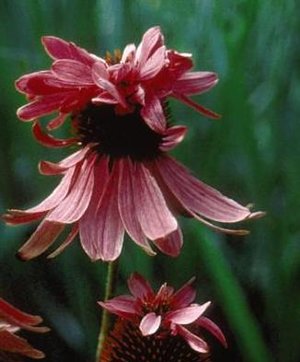
Native cultivars, sometimes called “nativars,” are patented plants. Once the plant breeder is satisfied,—with the double flower, the altered color, or whatever characteristic is being cultivated for—the plant is named, patented and marketed, then genetically identical plants are mass produced for sale. These plants will have a brand name in single quotation marks after the genus and species names, e.g., <i>Echinacea purpurea</i> ‘Double Decker,’ (pictured, with its freakish second set of ray flowers sticking out of the cones).

<i>Echinacea purpurea</i> ‘Double Decker’
Once on the shelf at the garden center, a cultivar is a brand-name product whose royalties flow to the breeder for as long as that cultivar sells. Combine this with many gardeners’ tendency to seek novelty and you’ve got the production/consumption pressures that ensure a steady stream of new ornamental cultivars showing up for sale.
So, what’s the problem with all these cultivars? We have a number of objections to cultivars of native plants. Here are a few:
Pollen and nectar availability.When a flower with a differently sized, colored, or shaped flower is bred from a native plant, the insects that evolved specialized mouthparts for that plant or responses to its visual cues such as nectar guides, may no longer be able to recognize the plant or be able to reach its nectar and/or pollen. Cultivars often have less pollen and nectar in the first place, and double flowers none at all.
Less seed for birds.Many cultivars are sterile, offering nothing in the way of seed to sustain for wildlife.
Caterpillar impact. Research has shown that when foliage color is changed to red or purple, normal insect feeding is significantly reduced. For other traits, such as disease resistance, insect feeding may be increased. So we know that changes in leaf chemistry affect insects’ eating patterns. We say leaf chemistry changes may very well affect insect health and development—and we’d like to see research on that, too.
Constricted genetic diversity. As the climate changes, survival of plants may depend in part on having the flexibility to adapt through genetic diversity. Genetically identical cultivars represent an impoverishment of a species’ gene pool, and individual cultivars—which have been bred to express a narrowed set of traits—are less able to adapt to environmental stresses.
Contamination of the gene pool. Some cultivars can cross-breed with wild plants, contaminating the wild gene pool with their tampered-with genes.
There are other reasons we avoid cultivars of native plants, but we’ll just add this: so many of these designer plants are simply freakish-looking to us. If insects could talk to us, we imagine they’d say, “Whoah, what is THAT!” upon encountering some of these cultivars.
Finally, the natural beauty of “true species” native plants and the ways they interact and support the rest of the native food web is just plain miraculous, requiring no human intervention.